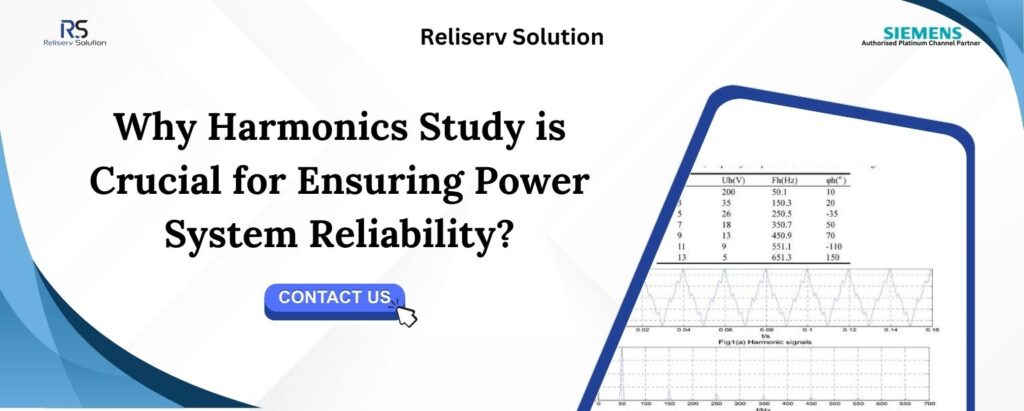Understanding Harmonics Study and Analysis and Their Impact on Power Systems
Harmonics are electric voltages and currents that distort the normal waveform of an electrical power system. These distortions can cause severe power quality issues, leading to equipment malfunction, overheating, and system failures. With the increasing use of non-linear loads such as variable frequency drives, LED lighting, and UPS systems, the presence of harmonics has become a growing concern for industrial and commercial facilities.
Harmonic distortion affects power system efficiency and reliability, making it essential for engineers and facility managers to conduct thorough harmonics studies and analyses. By identifying and mitigating harmonic distortions, facilities can prevent failures, reduce downtime, and ensure the smooth operation of electrical systems.
The Consequences of Harmonics Study and Analysis Distortion
Uncontrolled harmonic distortion can lead to a range of electrical system issues, including:
- Circulating Currents and High Voltages: Harmonic resonance can cause excessive currents and voltages, leading to insulation failure and equipment damage.
- Equipment Malfunctions: Excessive voltage distortion can interfere with the operation of sensitive equipment, causing unexpected shutdowns and failures.
- Increased Energy Losses: Harmonics lead to additional heating in electrical components, shortening their lifespan and increasing maintenance costs.
- False Tripping of Circuit Breakers: Protective devices may misinterpret harmonic currents as fault conditions, resulting in unnecessary shutdowns.
- Metering Errors: High harmonic content can affect the accuracy of power meters, leading to incorrect billing and energy management.
- Fire Hazards: Overheating of wiring and distribution systems due to harmonics can increase the risk of electrical fires.
- Generator Failures: Harmonics can create unstable operating conditions for generators, leading to poor performance and potential failures.
- Reduced Power Factor: Increased harmonic content results in a lower power factor, leading to higher utility charges and inefficiencies in power delivery.
The Necessity of Harmonics Study and Analysis
Although harmonics do not always pose a problem, when they do, they can significantly compromise power system reliability. Harmonics studies help identify potential risks and provide mitigation strategies before problems arise. These studies are particularly crucial in facilities with a high concentration of non-linear loads.
According to IEEE Std. 519-1992, harmonics should remain within acceptable limits to ensure reliable and safe power system operation. Facilities exceeding these limits must conduct harmonics studies to prevent undesirable effects.
When Should a Harmonic Study Be Conducted?
A harmonic study should be performed in the following scenarios:
- During the Design Stage of a Project: If non-linear loads exceed 25% of the total system load, a harmonics analysis is necessary to ensure compliance with power quality standards.
- Troubleshooting Electrical Failures: When electrical equipment malfunctions or protective relays fail, a harmonic study can help identify and resolve the issue.
- Facility Expansion: When adding significant non-linear loads to an existing system, a harmonic analysis is required to ensure system stability.
- Capacitor Bank Addition: When installing capacitor banks in systems with non-linear loads, a harmonics study helps assess the risk of harmonic resonance and determine mitigation strategies.
What Happens During a Harmonics Study and Analysis?
Harmonics analysis is a mathematical process that predicts potential harmonic distortion levels and resonance conditions in an electrical system. This study involves modeling power system components and analyzing their response to harmonic currents.
The key aspects of a harmonics study include:
- Current and Voltage Distortion Analysis: Evaluating harmonic distortions at different system buses and comparing results with predefined limits.
- Impedance vs. Frequency Analysis: Plotting system impedance at various buses to identify potential resonance conditions.
- Harmonic Frequency Spectrum Analysis: Examining individual harmonic components in relation to the fundamental frequency.
- Resonance Detection: Identifying and mitigating conditions where harmonic resonance could amplify voltage and current distortions.

How Harmonics Study and Analysis Are Performed
A harmonic study involves multiple steps, each critical for accurate analysis and effective mitigation strategies:
Step-by-Step Harmonic Study Process
- Obtain Electrical System One-Line Diagram: Identify non-linear loads, capacitor banks, and medium-voltage cables.
- Determine Point of Common Coupling (PCC): Identify the junction between the industrial network and the utility supply.
- Highlight Affected System Buses: Focus on buses likely to experience significant harmonic distortions.
- Collect Harmonic Data of Non-Linear Loads: Gather waveform data from various equipment to assess their harmonic impact.
- Obtain Utility Harmonic Data: Request voltage and current harmonic levels from the utility provider to compare against permitted limits.
- Model the Electrical Network: Use software like ETAP (Electrical Transient Analyzer Program) to simulate the power system.
- Perform Harmonic Analysis for Different Scenarios: Assess system behavior under various operating conditions.
- Verify Harmonic Distortion Levels: Compare calculated harmonic levels against IEEE and utility limits.
- Analyze Harmonic Frequency Spectrum: Examine the distribution of harmonics across different frequencies.
- Identify Corrective Actions if Required: Implement necessary mitigation solutions if harmonics exceed acceptable levels.
- Re-evaluate System Performance: Conduct a final study after implementing mitigation measures to confirm compliance.
Harmonic Mitigation Strategies
If a harmonic study reveals excessive distortion, several corrective actions can be taken:
- Use Higher-Pulse Rectifiers: Implementing rectifiers with more than six pulses reduces harmonic generation.
- Optimize Capacitor Bank Placement: Shifting or disconnecting small power factor correction capacitors can alter resonant frequencies.
- Install Harmonic Filters: Passive or active filters can absorb unwanted harmonic frequencies.
- Adopt Pulse Width Modulated (PWM) Rectifiers: These rectifiers minimize harmonic generation by controlling switching frequencies.
- Reconfigure System Loads: Adjusting the placement and operation of non-linear loads can help distribute harmonic currents more evenly.
Conclusion
Harmonics study and analysis play a crucial role in ensuring power system reliability and efficiency. As non-linear loads continue to grow in modern electrical systems, addressing harmonic distortion is more important than ever. By conducting thorough harmonics studies, facilities can prevent costly equipment failures, improve power quality, and comply with industry standards.
We specialize in harmonics analysis using ETAP and other advanced tools, ensuring reliable and efficient power system operation. Contact us today for expert harmonics study services and safeguard your electrical infrastructure from harmonic-related disruptions.
With its headquarters in Mumbai, Maharashtra, Reliserv Solution is both a Siemens Authorized supplier and a Platinum Channel Partner. A variety of our specialized services and solutions are also available to the panel building industry and other industries. If you have any queries about Harmonics Study and Analysis Provider or require assistance, please contact us by phone for Harmonics Study and Analysis Cost at +917506112097 or by email at [email protected]. Click the link to see our list of all the Field Services we offer. Over the years, we have provided a wide range of additional services in addition to the well-known Voltage Drop Study and Analysis.



